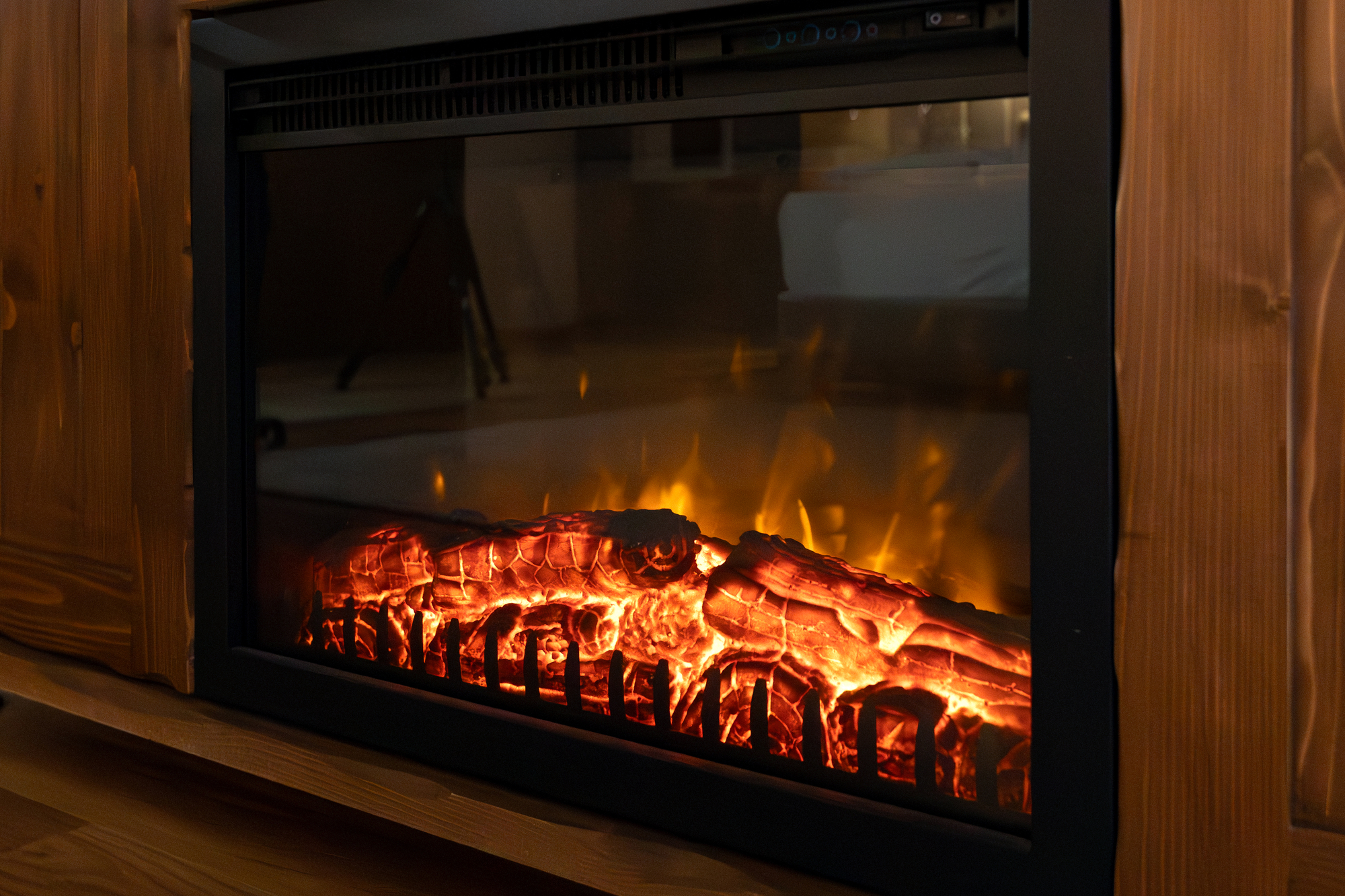Find out about the various fireplaces available for your home, including those based on the fuel type, mounting type, materials, and more.
It’s great to have a fireplace in your house. Fireplaces are permitted in several rooms.
Although many jurisdictions have outlawed wood fireplaces in newly constructed homes, they can still be charming in a thoughtful way. In actuality, gas fireplaces are both more practical and environmentally responsible.
We have a gas fireplace and a wood-burning fireplace. Our living room wood fireplace is great right now because our 5-year-old loves to build fires, but once that wears out.
We’ll wish we had a gas fireplace instead. We never use the gas fireplace in the basement because it is there.
Many consider constructing or renovating an indoor fireplace when considering home remodeling ideas. Fireplaces change the atmosphere of a room, making it cozier and more romantic while heating it.
You can buy numerous indoor fireplaces, but they essentially fall into one of four categories: electric, gas, or wood burning.
Consider the following information on the different fireplace types when choosing.
1. Electric Fireplace

Electric fireplaces are quickly overtaking other fuel types in popularity. Consider an effective infrared fireplace if you’re serious about getting an electric fireplace.
They heat the interior coils with electricity to produce warmth. Most models have an internal fan to help distribute heat in your home.
Electric fireplaces use a “fake” flame to create the illusion of a real flame because there isn’t one inside them. A crackling “fake” log frequently accompanies the flickering flame.
Most electric fireplace models allow you to turn off the heating element while leaving the fake flickering flame on to maintain the cozy ambiance if your home becomes too warm.
Even better, you can operate your electric fireplace comfortably in your chair. Most models include a remote control that you can use to adjust the temperature and turn on or off the fireplace.
Furthermore, an electric fireplace’s overall cost-effectiveness is one of its most significant advantages. They’re among the least expensive and easiest to install because they don’t need venting.
Moreover, unlike wood and gas fireplaces, electric fireplaces don’t need routine maintenance, such as chopping wood, cleaning the chimney, or checking the gas line.
2. Gas Fireplace
Another well-liked substitute for conventional wood-burning fireplaces is a gas fireplace. Like electric fireplaces, gas fireplaces are affordable and simple to install. You can keep a fireplace and chimney in place while installing built-in options.
Gas fireplaces are inexpensive initially and very efficient. They are wise if you want to reduce your overall heating utility costs.
An alternative is a free-standing gas fireplace that connects to a pipe. This allows you to install your fireplace in any room instead of just those already designed to accommodate one.
Models with direct venting need a chimney for ventilation. This can be an existing chimney (like one you formerly used for a wood fireplace) or a newly built chimney.
As mentioned, a pipe is another option that restricts changes to your home’s structure. Models without vents don’t need a chimney, pipe, or any other type of vent. These have many features that support general safety.
Despite generally burning clear, there is a slight chance they could release contaminants into your home. This is one of the different types of fireplaces.
3. Direct Vent Gas Fireplace
Direct vent systems use a stove pipe to draw in air and exhaust it directly outside. Because they do not draw air inside the building, they are the best option for highly well-sealed, high-efficiency homes.
4. B-Vent Gas Fireplace
B-vent fireplaces are similar to wood-burning fireplaces in appearance and operation. Like open-hearth fireplaces, they are open to the room but generate heat using a gas burner and valve system.
Furthermore, the natural vent piping that these fireplaces use in place of a chimney is referred to as “B-vent.” They are excellent options for warmer climates where the decorative aspect is more important than the heating capacity because they look nice but don’t produce much heat.
5. Vent-Free Gas Fireplace
Vent-free or “ventless” systems, such as a B-vent or open-hearth fireplace, are frequently open to the room. They are incredibly well-liked because of how simple they are to install. They are also very effective, but you cannot use their output restrictions for basic home heating requirements.
Vent-free fireplaces are best suited for large, high-ceilinged rooms with plenty of space for the carbon dioxide and humidity they emit to dissipate.
They generate a blue flame instead of the direct vent option’s yellow flame, which more closely resembles a natural fire.
6. Gel Fireplace
Although much less common than electric or gas fireplaces, gel fireplaces have some advantages. Their simplicity of installation is at the top of the list.
A gel fuel can is all needed to operate a gel fireplace. Therefore, venting, lines, pipes, and electrical wires are unnecessary.
A gel fireplace is more adaptable because it is self-contained. This model is frequently light enough to be mounted securely on a wall.
The actual flame is yet another appealing feature of a gel fireplace. Light the gel fuel can come with a lighter to make a real burn.
On the other hand, the minimal heat output is caused by the fuel type and this type of flame. You shouldn’t use a fireplace as your primary source of heat.
7. Ethanol Fireplace
A gel fireplace and an ethanol fireplace are very similar, except the latter uses liquid bioethanol fuel instead of the former.
The burner in most ethanol fireplaces can easily be filled with bioethanol for repeated use. The fuel tank’s standard volume is 2 liters.
The burner allows you to change the fireplace’s temperature using it (unlike a gel fireplace) and quickly turn it on and off.
An ethanol fireplace is simple to install but inefficient, much like gel fireplaces.
Furthermore, you shouldn’t rely solely on yours to heat your house. They are versatile, another quality they have in common with gel fireplaces. Also, due to their lightweight, they are an excellent option for a tabletop or wall-mounted fireplace.
8. Wood-Burning Fireplace
The most conventional type of fireplace is an old-fashioned wood-burning fireplace. Humans have been using a wood-burning fireplace to stay warm for a long time. When you think of a fireplace, a wood-burning fireplace is the first thing that comes to mind.
As the name suggests, a wood-burning fireplace produces heat by burning wood. Although this heat source makes a crackling or roaring fire, it has many drawbacks.
Furthermore, the cost and upkeep of wood-burning fireplaces are their most significant drawbacks. Installing them costs money, and buying wood and regular professional cleaning is necessary.
Despite these drawbacks, many people adore wood-burning fireplaces. They enjoy the smoky scent, which gives any space a cozy, rustic feel.
There are many different types of wood-burning fireplaces. Wood-burning stoves are a fantastic alternative for people who don’t have space for a fireplace, even though they aren’t technically fireplaces.
9. Traditional Open-Hearth Fireplace
You can use only a wood-burning fireplace with a traditional fireplace. These are also referred to as open hearth fireplaces and are typically built into the wall of your home from stone or brick. For ventilation, they use a flue and a chimney.
The most expensive mounting choice is a conventional fireplace. Building one properly will require much construction if you don’t already have one in your house.
Due to this, most people avoid traditional open-hearth fireplaces unless they are included in the design of their homes.
10. Free-Standing Fireplace
An excellent replacement for a conventional open-hearth fireplace is a free-standing fireplace.
They frequently have a mantel and are made to resemble a classic built-in fireplace. Depending on the fuel it burns (for ventilation), your free-standing fireplace may be completely free-standing or attached to the wall or ceiling.
Moving free-standing electric models that don’t need ventilation while redecorating is possible. Gas-free-standing fireplaces that require a gas line or ventilation should probably remain.
Free-standing fireplaces are available in various modern, contemporary, and rustic styles. They also come in a wide variety of sizes and shapes. This is one of the different types of fireplaces.
11. Wall-Mounted Fireplace
An excellent replacement for a conventional open-hearth fireplace is a free-standing fireplace. They frequently have a mantel and are made to resemble a classic built-in fireplace.
Depending on the fuel it burns (for ventilation), your free-standing fireplace may be completely free-standing or attached to the wall or ceiling.
Moving free-standing electric models that don’t need ventilation while redecorating is possible. Gas-free-standing fireplaces that require a gas line or ventilation should probably remain.
Furthermore, free-standing fireplaces are available in various modern, contemporary, and rustic styles and in a wide variety of sizes and shapes.
12. Built-In Fireplace
You can use an existing traditional fireplace with a fireplace insert. If your home has an open-hearth wood-burning fireplace, you can purchase an electric, gas, gel, or ethanol insert that slides into the existing opening.
This is a great way to transform a wood-burning fireplace that requires a lot of maintenance into one that requires less maintenance and is more energy-efficient.
Furthermore, fireplace inserts benefit from using your existing space. You can choose a model with these conventional aesthetics or build on them.
13. Tabletop Fireplace
Tabletop fireplaces are incredibly portable, lightweight fireplaces that are simple to move from room to room.
They are most frequently used to heat outdoor areas. Place yours on a tabletop to keep your guests warm and create a captivating focal point for the evening. A patio deck by the pool looks great, with a tabletop fireplace.
14. Wood Burning Stoves
A free-standing, solid steel or cast-iron box is a wood-burning stove with a metal stove pipe to vent the smoke. The Environmental Protection Agency regulates and certifies them for efficiency, making them significantly more efficient than open-hearth fireplaces.
Although not technically fireplaces, wood-burning stoves are a substitute that retains a lot of the romance of burning wood while outperforming open-hearth fireplaces in several ways.
For instance, a wood-burning stove uses less firewood to produce more usable heat than an open-hearth fireplace.
Even in the harshest climates, wood stoves are a practical way to satisfy the daily heating needs of homes up to several thousand square feet. This is one of the different types of fireplaces.
15. Enclosed Zero Clearance Fireplace
A fully enclosed metal firebox, similar to a wood stove that is built directly into the wall of a home, similar to an open-hearth fireplace, is what is known as an indoor enclosed wood-burning fireplace, also known as a “zero clearance manufactured fireplace.”
Like inserts, many have glass fronts, but since they are directly framed into the house, they can be much larger than inserts, which must fit inside an existing firebox.
The name comes from the almost zero clearance of this type of fireplace to the combustible surface. A zero-clearance fireplace is available and can burn wood, wood pellets, or gas.
16. Outdoor Fireplace And Fire Pits
Although indoor fireplaces are the most popular type, there is no reason to limit your wood-burning activities to the interior of your home.
While COVID puts a damper on indoor gatherings, an outdoor fireplace or fire pit creates a cozy focal point for outdoor gatherings, making them ideal for entertaining guests.
If you are determined to add a wood-burning fireplace, the outdoors might be the best place. Furthermore, you can build an outdoor fireplace for less money than an indoor fireplace.
Similarly, creating an outdoor fireplace is permitted in some jurisdictions where new indoor fireplaces are prohibited. However, before starting construction, you should check local laws.
There are numerous options for burning wood outside. Built-in outdoor fireplaces are substantial structures intended to remain in one location permanently, similar to an indoor open hearth. They can be built from scratch or with the aid of a kit.
An easier choice is a fire pit. A fire pit can be a physical pit or platform on the ground where an open fire can be built or an elevated metal bowl-like container that stands alone.
Another choice is a portable outdoor fireplace resembling a cross between a fire pit and a wood stove. Similarly, “chimeneas” are open-fronted, round-bellied terra cotta fireplaces with narrow chimneys on top and are frequently used for cooking.








